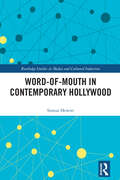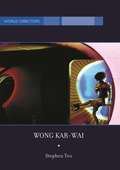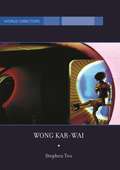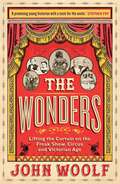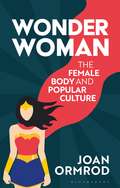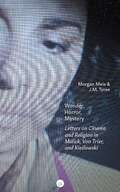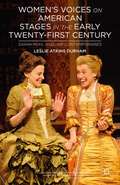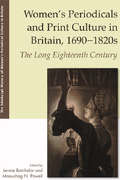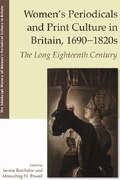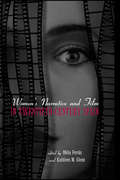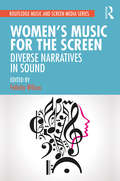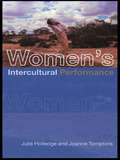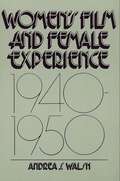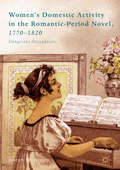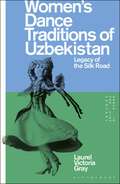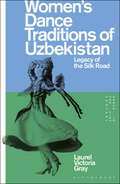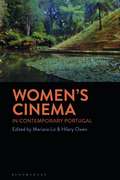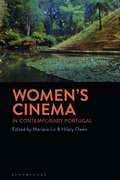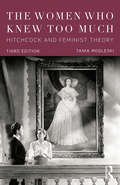- Table View
- List View
Word-of-Mouth in Contemporary Hollywood (Routledge Studies in Media and Cultural Industries)
by Simon HewittWord-of-Mouth in Contemporary Hollywood provides a unique insight into the potential for online communication to enable audiences to exert a greater impact on film industrial practices than ever before. In an overarching analysis of contemporary Hollywood film financing, marketing, distribution, and exhibition practices, Simon Hewitt recontextualises word-of-mouth in light of social media and examines the growing impact of audience participation. Using a ‘Bourdieuconomic’ approach, he applies qualitative research methods to better understand the contemporary Hollywood film audience, the contemporary Hollywood film industry, and the mechanisms that connect the two. The book explores new film financing mechanisms that incorporate fans into the packages used to secure production funds. It assesses the role of ‘Grassroots Intermediaries’ in contemporary film marketing campaigns. It critiques ‘democratic’ crowdsourced methods of film distribution, and finally, it considers the possible future of Hollywood film exhibition. By helping to bridge the gap between the gift economy and commodity culture, this book will appeal to students and scholars of media industry studies, media finance and economics, fan and audience studies, film studies, film history, and media marketing.
Word-of-Mouth in Contemporary Hollywood (Routledge Studies in Media and Cultural Industries)
by Simon HewittWord-of-Mouth in Contemporary Hollywood provides a unique insight into the potential for online communication to enable audiences to exert a greater impact on film industrial practices than ever before. In an overarching analysis of contemporary Hollywood film financing, marketing, distribution, and exhibition practices, Simon Hewitt recontextualises word-of-mouth in light of social media and examines the growing impact of audience participation. Using a ‘Bourdieuconomic’ approach, he applies qualitative research methods to better understand the contemporary Hollywood film audience, the contemporary Hollywood film industry, and the mechanisms that connect the two. The book explores new film financing mechanisms that incorporate fans into the packages used to secure production funds. It assesses the role of ‘Grassroots Intermediaries’ in contemporary film marketing campaigns. It critiques ‘democratic’ crowdsourced methods of film distribution, and finally, it considers the possible future of Hollywood film exhibition. By helping to bridge the gap between the gift economy and commodity culture, this book will appeal to students and scholars of media industry studies, media finance and economics, fan and audience studies, film studies, film history, and media marketing.
Wong Kar-Wai: Auteur of Time (World Directors)
by Stephen TeoThis study of Hong Kong cult director Wong Kar-wai provides an overview of his career and in-depth analysis of his seven feature films to date. Teo probes Wong's cinematic and literary influences - from Martin Scorsese to Haruki Murakami - yet shows how Wong transcends them all.
Wong Kar-Wai: Auteur of Time (World Directors)
by Stephen TeoThis study of Hong Kong cult director Wong Kar-wai provides an overview of his career and in-depth analysis of his seven feature films to date. Teo probes Wong's cinematic and literary influences - from Martin Scorsese to Haruki Murakami - yet shows how Wong transcends them all.
The Wonders: Lifting the Curtain on the Freak Show, Circus and Victorian Age
by John Woolf'A promising young historian with a taste for the exotic.' Stephen FryThe Wonders is a radical new history of the Victorian age: meet the forgotten and extraordinary freak performers whose talents and disabilities helped define an era.On 23 March, 1844, General Tom Thumb, at 25 inches tall, entered the Picture Gallery at Buckingham Palace and bowed low to Queen Victoria. On both sides of the Atlantic, this meeting marked a tipping point in the nineteenth century – the age of the freak was born. Bewitching all levels of society, it was a world of astonishing spectacle – of dwarfs, giants, bearded ladies, Siamese twins and swaggering showmen – and one that has since inspired countless novels, films and musicals. But the real stories (human dramas that so often eclipsed the fantasy presented on the stage), of the performing men, women and children, have been forgotten or marginalized in the histories of the very people who exploited them. In this richly evocative account, Dr John Woolf uses a wealth of recently discovered material to bring to life the sometimes tragic, sometimes triumphant, always extraordinary stories of people who used their (dis)abilities and difference to become some of the first international celebrities. And through their lives we discover afresh some of the great transformations of the age: the birth of showbusiness, of celebrity, of advertising, of ‘alternative facts’; while also exploring the tensions between the power of fame, the impact of exploitation and our fascination with ‘otherness’.
Wonder Woman: The Female Body and Popular Culture
by Joan OrmrodWonder Woman was created in the early 1940s as a paragon of female empowerment and beauty and her near eighty-year history has included seismic socio-cultural changes. In this book, Joan Ormrod analyses key moments in the superheroine's career and views them through the prism of the female body. This book explores how Wonder Woman's body has changed over the years as her mission has shifted from being an ambassador for peace and love to the greatest warrior in the DC transmedia universe, as she's reflected increasing technological sophistication, globalisation and women's changing roles and ambitions. Wonder Woman's physical form, Ormrod argues, is both an articulation of female potential and attempts to constrain it. Her body has always been an amalgamation of the feminine ideal in popular culture and wider socio-cultural debate, from Betty Grable to the 1960s 'mod' girl, to the Iron Maiden of the 1980s.
Wonder Woman: The Female Body and Popular Culture
by Joan OrmrodWonder Woman was created in the early 1940s as a paragon of female empowerment and beauty and her near eighty-year history has included seismic socio-cultural changes. In this book, Joan Ormrod analyses key moments in the superheroine's career and views them through the prism of the female body. This book explores how Wonder Woman's body has changed over the years as her mission has shifted from being an ambassador for peace and love to the greatest warrior in the DC transmedia universe, as she's reflected increasing technological sophistication, globalisation and women's changing roles and ambitions. Wonder Woman's physical form, Ormrod argues, is both an articulation of female potential and attempts to constrain it. Her body has always been an amalgamation of the feminine ideal in popular culture and wider socio-cultural debate, from Betty Grable to the 1960s 'mod' girl, to the Iron Maiden of the 1980s.
Wonder, Horror, Mystery: Letters on Cinema and Religion in Malick, Von Trier, and Kieślowski
by J.M. Tyree Morgan MeisWonder, Horror, Mystery is a dialogue between two friends, both notable arts critics, that takes the form of a series of letters about movies and religion. One of the friends, J.M. Tyree, is a film critic, creative writer, and agnostic, while the other, Morgan Meis, is a philosophy PhD, art critic, and practicing Catholic. The question of cinema is raised here in a spirit of friendly friction that binds the personal with the critical and the spiritual. What is film? What’s it for? What does it do? Why do we so intensely love or hate films that dare to broach the subjects of the divine and the diabolical? These questions stimulate further thoughts about life, meaning, philosophy, absurdity, friendship, tragedy, humor, death, and God. The letters focus on three filmmakers who challenged secular assumptions in the late 20th century and early 21st century through various modes of cinematic re-enchantment: Terrence Malick, Lars von Trier, and Krzysztof Kieślowski. The book works backwards in time, giving intensive analysis to Malick’s To The Wonder (2012), Von Trier’s Antichrist (2009), and Kieślowski’s Dekalog (1988), respectively, in each of the book’s three sections. Meis and Tyree discuss the filmmakers and films as well as related ideas about philosophy, theology, and film theory in an accessible but illuminating way. The discussion ranges from the shamelessly intellectual to the embarrassingly personal. Spoiler alert: No conclusions are reached either about God or the movies. Nonetheless, it is a fun ride.
Women's Voices on American Stages in the Early Twenty-First Century: Sarah Ruhl and Her Contemporaries
by L. DurhamWomen are at the center of American theatre and have the potential to shape the cultural imagination of theatre-goers as a complex new era unfolds. Sarah Ruhl, one of the twenty-first century's most honored playwrights, is read in concert with her contemporaries whose writing also wrestles with the vexing issues facing Americans in the new century.
Women's Periodicals and Print Culture in Britain, 1690-1820s: The Long Eighteenth Century
by Jennie Batchelor Manushag N. PowellDefinitive modern edition of Stevenson’s intriguing account of his emigration from Scotland to California
Women's Periodicals and Print Culture in Britain, 1690-1820s: The Long Eighteenth Century (The\edinburgh History Of Women's Periodical Culture In Britain Ser.)
by Jennie Batchelor Manushag N. PowellExamines the practices of independent digital feature-filmmaking in contemporary Britain
Women's Narrative and Film in 20th Century Spain
by Kathleen GlennWomen's Narrative and Film in 20th Century Spain examines the development of the feminine cultural tradition in spain and how this tradition reshaped and defined a Spanish national identity. Each chapter focuses on representation of autobiography, alienation and exile, marginality, race, eroticism, political activism, and feminism within the ever-changing nationalisms in different regions of Spain. The book describes how concepts of gender and difference shaped the individual, collective, and national identities of Spanish women and significantly modified the meaning and representation of female sexuality.
Women's Narrative and Film in 20th Century Spain
by Kathleen GlennWomen's Narrative and Film in 20th Century Spain examines the development of the feminine cultural tradition in spain and how this tradition reshaped and defined a Spanish national identity. Each chapter focuses on representation of autobiography, alienation and exile, marginality, race, eroticism, political activism, and feminism within the ever-changing nationalisms in different regions of Spain. The book describes how concepts of gender and difference shaped the individual, collective, and national identities of Spanish women and significantly modified the meaning and representation of female sexuality.
Women's Music for the Screen: Diverse Narratives in Sound
by Felicity WilcoxWomen’s Music for the Screen: Diverse Narratives in Sound shines a long-overdue light on the works and lives of female-identifying screen composers. Bringing together composer profiles, exclusive interview excerpts, and industry case studies, this volume showcases their achievements and reflects on the systemic gender biases women have faced in an industry that has long excluded them. Across 16 essays, an international array of contributors present a wealth of research data, biographical content, and musical analysis of film, television, and video game scores to understand how the industry excludes women, the consequences of these deficits, and why such inequities persist – and to document women’s rich contributions to screen music in diverse styles and genres.The chapters amplify the voices of women composers including Bebe Barron, Delia Derbyshire, Wendy Carlos, Anne Dudley, Rachel Portman, Hildur Guðnadóttir, Mica Levi, Winifred Phillips, and more. From the mid-twentieth century to the present, and from classic Hollywood scores to pioneering electronic music, these are the stories and achievements of the women who have managed to forge successful careers in a male-dominated arena. Suitable for researchers, educators, and students alike, Women’s Music for the Screen urges the screen music industry to consider these sounds and stories in a way it hasn’t before: as voices that more accurately reflect the world we all share.
Women's Music for the Screen: Diverse Narratives in Sound
by Felicity WilcoxWomen’s Music for the Screen: Diverse Narratives in Sound shines a long-overdue light on the works and lives of female-identifying screen composers. Bringing together composer profiles, exclusive interview excerpts, and industry case studies, this volume showcases their achievements and reflects on the systemic gender biases women have faced in an industry that has long excluded them. Across 16 essays, an international array of contributors present a wealth of research data, biographical content, and musical analysis of film, television, and video game scores to understand how the industry excludes women, the consequences of these deficits, and why such inequities persist – and to document women’s rich contributions to screen music in diverse styles and genres.The chapters amplify the voices of women composers including Bebe Barron, Delia Derbyshire, Wendy Carlos, Anne Dudley, Rachel Portman, Hildur Guðnadóttir, Mica Levi, Winifred Phillips, and more. From the mid-twentieth century to the present, and from classic Hollywood scores to pioneering electronic music, these are the stories and achievements of the women who have managed to forge successful careers in a male-dominated arena. Suitable for researchers, educators, and students alike, Women’s Music for the Screen urges the screen music industry to consider these sounds and stories in a way it hasn’t before: as voices that more accurately reflect the world we all share.
Women's Intercultural Performance
by Julie Holledge Joanne TompkinsThis is the first in-depth examination of contemporary intercultural performance by women around the world. Contemporary feminist performance is explored in the contexts of current intercultural practices, theories and debates. Holledge and Tompkins provide ways of thinking about and analysing contemporary performance and representations of the performing, female, culturally-marked body. The book includes discussions of: * ritual performance by women from Central Australia and Korea * the cultural exchange of A Doll's House and Antigone * plays from Algeria, South Africa and Ghana * the work of the Takarazuka revue company * the market forces that govern the distribution of women and women's performance. This is an essential read for anyone studying or interested in women's performance.
Women's Intercultural Performance
by Julie Holledge Joanne TompkinsThis is the first in-depth examination of contemporary intercultural performance by women around the world. Contemporary feminist performance is explored in the contexts of current intercultural practices, theories and debates. Holledge and Tompkins provide ways of thinking about and analysing contemporary performance and representations of the performing, female, culturally-marked body. The book includes discussions of: * ritual performance by women from Central Australia and Korea * the cultural exchange of A Doll's House and Antigone * plays from Algeria, South Africa and Ghana * the work of the Takarazuka revue company * the market forces that govern the distribution of women and women's performance. This is an essential read for anyone studying or interested in women's performance.
Women's Film and Female Experience, 1940-1950
by Andrea WalshWomen's Film and Female Experience takes a fresh look at a wide range of popular women's films in order to discover what American female consciousness in the 1940s was really about. The author traces the evolution and development of the Hollywood women's film, and describes the social history of American women in the 1940s. She then analyzes dominant narrative patterns within popular women's films of the decade: the maternal drama, the career woman comedy, and the films of suspicion and distrust.
Women’s Domestic Activity in the Romantic-Period Novel, 1770-1820: Dangerous Occupations
by Joseph MorrisseyThis book examines women’s domestic occupations in the Romantic-period novel at the most intimately human level. By examining the momentary thought and feeling processes that informed the playing of a harp, the stitching of a dress, or the reading of a gothic novel, the book shifts the focus from women’s socio-cultural contributions through domestic endeavor to how women’s day-to-day tasks shaped experiences of joy, friendship, resentment, and self. Through an understanding of domestic occupations as forms of human action, the study emphasises the inherent unpredictability of quotidian activities and draws attention to their capacity for exceeding cultural parameters. Specifically, the book examines needlework, musical accomplishment, novel reading, and sensibility in the work of Charlotte Smith, Jane Austen, and Francis Burney, giving new perspectives on established canonical works while also providing the most sustained analysis of Charlotte Smith’s little studied novel, Ethelinde, to date.
Women’s Domestic Activity in the Romantic-Period Novel, 1770-1820: Dangerous Occupations
by Joseph MorrisseyThis book examines women’s domestic occupations in the Romantic-period novel at the most intimately human level. By examining the momentary thought and feeling processes that informed the playing of a harp, the stitching of a dress, or the reading of a gothic novel, the book shifts the focus from women’s socio-cultural contributions through domestic endeavor to how women’s day-to-day tasks shaped experiences of joy, friendship, resentment, and self. Through an understanding of domestic occupations as forms of human action, the study emphasises the inherent unpredictability of quotidian activities and draws attention to their capacity for exceeding cultural parameters. Specifically, the book examines needlework, musical accomplishment, novel reading, and sensibility in the work of Charlotte Smith, Jane Austen, and Francis Burney, giving new perspectives on established canonical works while also providing the most sustained analysis of Charlotte Smith’s little studied novel, Ethelinde, to date.
Women’s Dance Traditions of Uzbekistan: Legacy of the Silk Road (Dance in the 21st Century)
by Laurel Victoria GrayThe first comprehensive work in English on the three major regional styles of Uzbek women's dance – Ferghana, Khiva and Bukhara – and their broader Silk Road cultural connections, from folklore rootsto contemporary stage dance. The book surveys the remarkable development from the earliest manifestations in ancient civilizationsto a sequestered existence under Islam; from patronage under Soviet power to a place of pride for Uzbek nationhood. It considers the role that immigration had to play on the development of the dances; how women boldly challenged societal gender roles to perform in public; how both material culture and the natural world manifest in the dance; and it illuminates the innovations of pioneering choreographers who drew from Central Asian folk traditions, gestures and aesthetics – not Russian ballet – to first shape modern Uzbek stage dance. Written by the first American dancer invited to study in Uzbekistan, this book offers insight into the once-hidden world of Uzbek women's dance.
Women’s Dance Traditions of Uzbekistan: Legacy of the Silk Road (Dance in the 21st Century)
by Laurel Victoria GrayThe first comprehensive work in English on the three major regional styles of Uzbek women's dance – Ferghana, Khiva and Bukhara – and their broader Silk Road cultural connections, from folklore rootsto contemporary stage dance. The book surveys the remarkable development from the earliest manifestations in ancient civilizationsto a sequestered existence under Islam; from patronage under Soviet power to a place of pride for Uzbek nationhood. It considers the role that immigration had to play on the development of the dances; how women boldly challenged societal gender roles to perform in public; how both material culture and the natural world manifest in the dance; and it illuminates the innovations of pioneering choreographers who drew from Central Asian folk traditions, gestures and aesthetics – not Russian ballet – to first shape modern Uzbek stage dance. Written by the first American dancer invited to study in Uzbekistan, this book offers insight into the once-hidden world of Uzbek women's dance.
Women's Cinema in Contemporary Portugal
by Hilary Owen Mariana LizWomen's Cinema in Contemporary Portugal brings together scholars from Portugal, UK and the USA, to discuss 14 women film directors in Portugal, focussing on their production in both feature film and documentary genres over the last half-century. It charts the specific cinematic visions that these women have brought to the re-emergence of Portuguese national cinema in the wake of the 1974 Revolution and African decolonisation, and to the growing internationalisation of Portugal's arguably 'minor' or 'small nation' cinema, with significant young women directors such as Leonor Teles achieving prominence abroad. The history of Portuguese women's cinema only begins systematically after the 1974 revolution and democratisation. This collection shows how female auteurs made a specific mark on Portugal's post-revolutionary conceptualisation of a differently 'national' cinema, through the ethnographic output of the late 1970s. It goes on to explore women's decisively gendered interventions in the cinematic memory practices that opened up around the masculine domain of the Colonial Wars in Africa. Feminist political issues such as Portugal's 30-year abortion campaign and LGBT status have become more visible since the 1990s, alongside preoccupations with global concerns relating to immigration, transit and minority status communities. The book also demonstrates how women have made specific contributions to the evolution of soundscapes, the genre of essay cinema, film's relationship to the archive, and the adaptation of the written word. The result is a powerful, provocative and definitive challenge to the marginalisation of Portuguese female-directed film in terms of 'double minority'.
Women's Cinema in Contemporary Portugal
Women's Cinema in Contemporary Portugal brings together scholars from Portugal, UK and the USA, to discuss 14 women film directors in Portugal, focussing on their production in both feature film and documentary genres over the last half-century. It charts the specific cinematic visions that these women have brought to the re-emergence of Portuguese national cinema in the wake of the 1974 Revolution and African decolonisation, and to the growing internationalisation of Portugal's arguably 'minor' or 'small nation' cinema, with significant young women directors such as Leonor Teles achieving prominence abroad. The history of Portuguese women's cinema only begins systematically after the 1974 revolution and democratisation. This collection shows how female auteurs made a specific mark on Portugal's post-revolutionary conceptualisation of a differently 'national' cinema, through the ethnographic output of the late 1970s. It goes on to explore women's decisively gendered interventions in the cinematic memory practices that opened up around the masculine domain of the Colonial Wars in Africa. Feminist political issues such as Portugal's 30-year abortion campaign and LGBT status have become more visible since the 1990s, alongside preoccupations with global concerns relating to immigration, transit and minority status communities. The book also demonstrates how women have made specific contributions to the evolution of soundscapes, the genre of essay cinema, film's relationship to the archive, and the adaptation of the written word. The result is a powerful, provocative and definitive challenge to the marginalisation of Portuguese female-directed film in terms of 'double minority'.
The Women Who Knew Too Much: Hitchcock and Feminist Theory
by Tania ModleskiOriginally published in 1988, The Women Who Knew Too Much remains a classic work in film theory and feminist criticism. The book consists of a theoretical introduction and analyses of seven important films by Alfred Hitchcock, each of which provides a basis for an analysis of the female spectator as well as of the male spectator. Modleski considers the emotional and psychic investments of men and women in female characters whose stories often undermine the mastery of the cinematic "master of suspense." The third edition features an interview with the author by David Greven, in which he and Modleski reflect on how feminist and queer approaches to Hitchcock studies may be brought into dialogue. A teaching guide and discussion questions by Ned Schantz help instructors and students to delve into this seminal work of feminist film theory.
